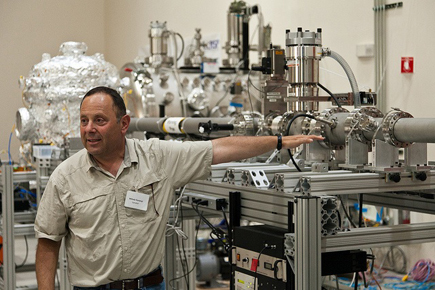
Mihaly Horanyi
Principal Investigator - onboard the LADEE Mission
I grew up in Budapest, Hungary.
In 1980, while a graduate student (in Hungary), I was hired to work on the Vega mission to comet Halley. At the same time the two Russian probes Vega 1 and Vega 2, the European Giotto and the Japanese were all in the works. The large international interest and the excitement of building instruments that would fly in deep space was mesmerizing to me.
For me, figuring out the most important science questions to ask, which measurements to make and what is the right balance between capability, reliability, mass, power needs, schedule, and cost remains challenging and exciting ever since.
I study cosmic dust, and dusty plasmas in space and in the laboratory. It was my good fortune to work on this topic as a graduate student just as it was about to "explode" into a new and rapidly growing field.
The in situ measurements taken during the comet Halley encounters in 1986 ignited an interest in this field. Since that time, we have recognized dusty plasma processes in action in planetary rings, in the Earth's atmosphere, and on the surfaces of all airless planetary objects. The topic remains of great interest in basic plasma physics, planetary and space physics, and atmospheric sciences.
I am always inspired by the mechanical engineers and the folks in the machine shops at the various institutions I have come across throughout my career who know how to make things work. As do the analog and digital electrical engineers in how they can give a "soul" to the boards, chips and wires.
The project managers who can keep things calm, collected and moving forward through the ups and downs of designing and building instruments to fly in space, and the folks who oversee the integration and testing of the instruments delivered to a spacecraft before launch give me inspiration for my work.
I find motivation in all of my colleagues who can dream up the goals, and who are willing to relentlessly invest their time and energy to get the data and learn new things about space.
A principle investigator (PI) is similar to a conductor of a large orchestra -- standing upfront, waving a stick in the air and somehow making the music fill the concert hall. Without the orchestra he/she would be rather comical!
A PI is responsible for writing a proposal with the right combination of science goals and technical details. If the proposal is selected, then his/her most important assignment is to work with the engineers and scientists to identify the best compromise between the science "wish-list" and the realities of the engineering requirements of the mission.
A PI has to push the boundaries, and at the same time manage risk, listen, and learn to compromise, stay humble, and remain capable of making decisions. I'm still learning how to do this.
In early 2006 we were at the Applied Physics Laboratory (APL) for the commissioning of the Student Dust Counter (SDC) instrument onboard the New Horizons mission to Pluto. After the initial "turn-on" command was sent, it took four minutes to get confirmation that SDC was on ... we all knew that by then New Horizons would be two light-minutes away, but it still remains the longest, most exciting four minutes I have ever experienced -- ever!
Do it! Work hard to convince the single most important critic of everything that you do -- yourself.
I love my job, it is also my hobby -- I enjoy working with students. In order to blow off some steam I like biking, hiking, skiing -- anything outdoors.
Great choices! Let me offer a quote here:
"The miracle of appropriateness of the language of mathematics for the formulation of the laws of physics is a wonderful gift which we neither understand nor deserve" (E. P. Wigner, Comm. Pure and Appl. Math. XIII. 1-14, 1960). Look it up!
Planetary science is a global profession.

